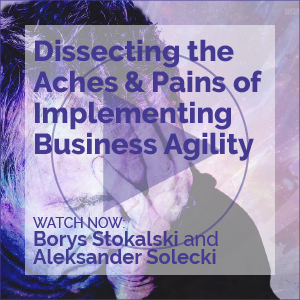Get That IT Project Back on Track
As a consultant, one of the things I am often asked to do are project reviews: when things have not gone well, the stakeholders are looking for recommendations to get their project back on track. When projects get into trouble it is often for one (or more) of the following reasons:
Get That IT Project Back on Track
As a consultant, one of the things I am often asked to do are project reviews: when things have not gone well, the stakeholders are looking for recommendations to get their project back on track. When projects get into trouble it is often for one (or more) of the following reasons:
Get That IT Project Back on Track
As a consultant, one of the things I am often asked to do are project reviews: when things have not gone well, the stakeholders are looking for recommendations to get their project back on track. When projects get into trouble it is often for one (or more) of the following reasons:
Get That IT Project Back on Track
As a consultant, one of the things I am often asked to do are project reviews: when things have not gone well, the stakeholders are looking for recommendations to get their project back on track. When projects get into trouble it is often for one (or more) of the following reasons:
More on Real-Time Business Intelligence
The Case for Digital Identity Management: Increased Competition
A Systemic Approach to Software Risk Management
[Excerpted from an article in the September 1992 Cutter IT Journal (formerly American Programmer).]
Vendors: Can't Live with Them, Can't Live Without Them
How do we think about vendors? Let me count the ways....
Vendors: Can't Live with Them, Can't Live Without Them
How do we think about vendors? Let me count the ways....
Vendors: Can't Live with Them, Can't Live Without Them
How do we think about vendors? Let me count the ways....
Vendors: Can't Live with Them, Can't Live Without Them
How do we think about vendors? Let me count the ways....
The Consortia
A Different Desktop Platform
I've recently read a series of articles on Linux desktop options, on Sun's Java Desktop, and on Apple as an alternative desktop. Most of the articles compared OS functionality and the cost per user. What most of the writers don't seem to understand is that, for most of us, a desktop OS is simply the platform on which we run the Microsoft Office suite.
Avoid the Stockholm Syndrome in Outsourcing
Managing risk is one of the keys to success in an outsourcing arrangement, and companies use many control mechanisms to manage risk in outsourcing deals. These control mechanisms can range from full-scale contract offices, project management offices, metrics, scorecard reporting, audits, CMMI assessments, and onsite oversight teams, or any combination of these.
Avoid the Stockholm Syndrome in Outsourcing
Managing risk is one of the keys to success in an outsourcing arrangement, and companies use many control mechanisms to manage risk in outsourcing deals. These control mechanisms can range from full-scale contract offices, project management offices, metrics, scorecard reporting, audits, CMMI assessments, and onsite oversight teams, or any combination of these.
A Different Desktop Platform
I've recently read a series of articles on Linux desktop options, on Sun's Java Desktop, and on Apple as an alternative desktop. Most of the articles compared OS functionality and the cost per user. What most of the writers don't seem to understand is that, for most of us, a desktop OS is simply the platform on which we run the Microsoft Office suite.
A Different Desktop Platform
I've recently read a series of articles on Linux desktop options, on Sun's Java Desktop, and on Apple as an alternative desktop. Most of the articles compared OS functionality and the cost per user. What most of the writers don't seem to understand is that, for most of us, a desktop OS is simply the platform on which we run the Microsoft Office suite.
Optimization Audits
The Lowdown on Service Orientation and Web Services
Most IT organizations today are struggling with the same problem: how to be more agile, responsive, and competitive. When we look at the companies that excel in these areas, we notice some similarities. First, these companies have taken an overall enterprise-wide approach to defining their business processes and the IT infrastructure needed to support them. Underlying and unifying the IT infrastructure is a service-oriented architecture (SOA). Second, these companies have implemented changes in their business and development organizations to support this new approach.
Exploring SOA Options
In a recent Cutter Consortium Enterprise Architecture E-Mail Advisor, I discussed IBM's Workplace Client Technology.1 As a cosponsor of SOAP, UDDI, BPEL (Business Process Execution Language), and its growing server suite WebSphere (which includes a wide variety of utilities including business process modeling facilities derived from its acquisition of Holosofx), IBM is clearly working hard to lay the groundwork for and encourage investment in SOA.


